『Python で学ぶ衛星データ解析基礎』を R でやってみる (2) 3章後半
本
前回まで
USGS Earth Explorer を利用したダウンロード方法
本では Landsat-8 の collection 1 が使われていましたが、collection 1 は現在では Earth Explorer からは選択できなくなっています。
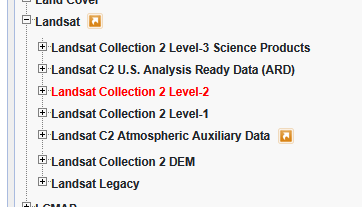
Landsat-8 collection 2 も AWS でオープンに公開されているんですが、本で使われていた collection 1 と違って、リクエスタ支払い、つまり使う人がお金を払う設定になっています。お金を払うといっても数枚ダウンロードする程度なら 10 円もかからないでしょう。ただ、このために認証なしでは使えなくなっていて、AWS のアカウントが必要です。AWS を使い慣れていない人にはちょっとハードルがあるかもしれません。
いちおう R で S3 を使う方法を書いておくと、s3fs パッケージ が便利っぽいです。request_payer = TRUE にするとリクエスタ支払いが有効にできます。ディレクトリの操作が s3_dir_*() で、ファイルの操作が s3_file_*() になっていて、まあちょっとドキュメントを読めば使えると思います。
s3fs::s3_file_system(
profile_name = "s3-public-access", # ~/.aws/credentials に設定している profile 名
request_payer = TRUE,
region_name = "us-west-2",
refresh = TRUE
)
s3fs::s3_dir_ls("s3://usgs-landsat/collection02/")
#> [1] "s3://usgs-landsat/collection02/catalog.json" "s3://usgs-landsat/collection02/landsat-c2l1.json"
#> [3] "s3://usgs-landsat/collection02/landsat-c2l2-sr.json" "s3://usgs-landsat/collection02/landsat-c2l2-st.json"
#> [5] "s3://usgs-landsat/collection02/landsat-c2l2alb-bt.json" "s3://usgs-landsat/collection02/landsat-c2l2alb-sr.json"
#> [7] "s3://usgs-landsat/collection02/landsat-c2l2alb-st.json" "s3://usgs-landsat/collection02/landsat-c2l2alb-ta.json"
#> [9] "s3://usgs-landsat/collection02/inventory" "s3://usgs-landsat/collection02/level-1"
#> [11] "s3://usgs-landsat/collection02/level-2"
本ではたぶん USGS/EROS にアカウントを作らせるのがめんどくさいということで AWS からダウンロードする方法が書かれていたんだと思いますが、USGS/EROS にアカウントをつくれば普通に Earth Explorer からダウンロードできるので、それが早いでしょう。しかもタダだし。
あるいは、前回と同じく STAC 経由でダウンロードするのもよさそうです。
stac_source <- rstac::stac("https://landsatlook.usgs.gov/stac-server")
available_collections <- stac_source |>
rstac::collections() |>
rstac::get_request()
available_collections
#> ###Collections
#> - collections (14 item(s)):
#> - landsat-c2l2-sr
#> - landsat-c2l2-st
#> - landsat-c2ard-st
#> - landsat-c2l2alb-bt
#> - landsat-c2l3-fsca
#> - landsat-c2ard-bt
#> - landsat-c2l1
#> - landsat-c2l3-ba
#> - landsat-c2l2alb-st
#> - landsat-c2ard-sr
#> - landsat-c2l2alb-sr
#> - landsat-c2l2alb-ta
#> - landsat-c2l3-dswe
#> - landsat-c2ard-ta
#> - field(s): collections, links, context
landsat-c2l2 というやつが collection 2(c2)の level 2(l2)らしいです。-sr となっているのが surface reflectance です。
available_collections$collections[[1]]
#> ###Collection
#> - id: landsat-c2l2-sr
#> - title: Landsat Collection 2 Level-2 UTM Surface Reflectance (SR) Product
#> - description:
#> The Landsat Surface Reflectance (SR) product measures the fraction of incoming solar radiation that is reflected from Earth's surface to the Landsat sensor.
#> - field(s): id, type, stac_version, stac_extensions, title, description, keywords, extent, providers, license, summaries, item_assets, links
これに対して検索して、eo:cloud_cover で並べ替えます。Landsat の場合は landsat:cloud_cover_land という属性も使えそうでした(たぶん陸地の被雲率?)。
items <- stac_source |>
rstac::stac_search(
collections = "landsat-c2l2-sr",
datetime = "2020-04-10T00:00:00Z/2021-06-11T00:00:00Z",
bbox = c(139.7081, 35.4818, 139.8620, 35.6594),
limit = 100
) |>
rstac::get_request()
library(dplyr)
items |>
rstac::items_as_tibble() |>
arrange(`eo:cloud_cover`) |>
select(datetime, `eo:cloud_cover`, `landsat:scene_id`)
#> # A tibble: 77 × 3
#> datetime `eo:cloud_cover` `landsat:scene_id`
#> <chr> <dbl> <chr>
#> 1 2021-02-11T01:16:19.484937Z 1.8 LC81070362021042LGN00
#> 2 2020-04-29T01:15:42.798843Z 2.82 LC81070362020120LGN00
#> 3 2020-04-29T01:15:18.912039Z 2.87 LC81070352020120LGN00
#> 4 2020-11-15T00:37:43.912865Z 3 LE71070352020320ASN00
#> 5 2021-02-19T00:30:45.813798Z 4 LE71070352021050ASN00
#> 6 2020-08-11T00:44:01.557498Z 4 LE71070352020224EDC00
#> 7 2020-11-23T01:16:09.260137Z 4.62 LC81070352020328LGN00
#> 8 2021-01-10T01:16:02.819631Z 4.7 LC81070352021010LGN00
#> 9 2021-05-10T00:24:15.368007Z 6 LE71070352021130EDC00
#> 10 2021-01-02T00:34:14.847940Z 6 LE71070352021002ASN00
#> # ℹ 67 more rows
#> # ℹ Use `print(n = ...)` to see more rows
そして rstac::assets_url() でダウンロードできる URL を調べます(被雲率がいちばん低いのは LC81070362021042LGN00 でしたが、ちょっと本で使ってたのと範囲がずれていたので LC81070352020120LGN00 にしました)。
items |>
rstac::items_filter(filter_fn = \(x) x$properties$`landsat:scene_id` == "LC81070352020120LGN00") |>
rstac::assets_url(c("red", "green", "blue"))
#> [1] "https://landsatlook.usgs.gov/.../LC08_L2SP_107036_20210211_20210302_02_T1_SR_B4.TIF"
#> [2] "https://landsatlook.usgs.gov/.../LC08_L2SP_107036_20210211_20210302_02_T1_SR_B3.TIF"
#> [3] "https://landsatlook.usgs.gov/.../LC08_L2SP_107036_20210211_20210302_02_T1_SR_B2.TIF"
注意点ですが、この URL はログインが必要なものになっているので、R からダウンロードすることはできません。ブラウザで開きましょう。すでにログインしていればそのままダウンロードが開始され、ログインしていなければログイン画面が出ます。
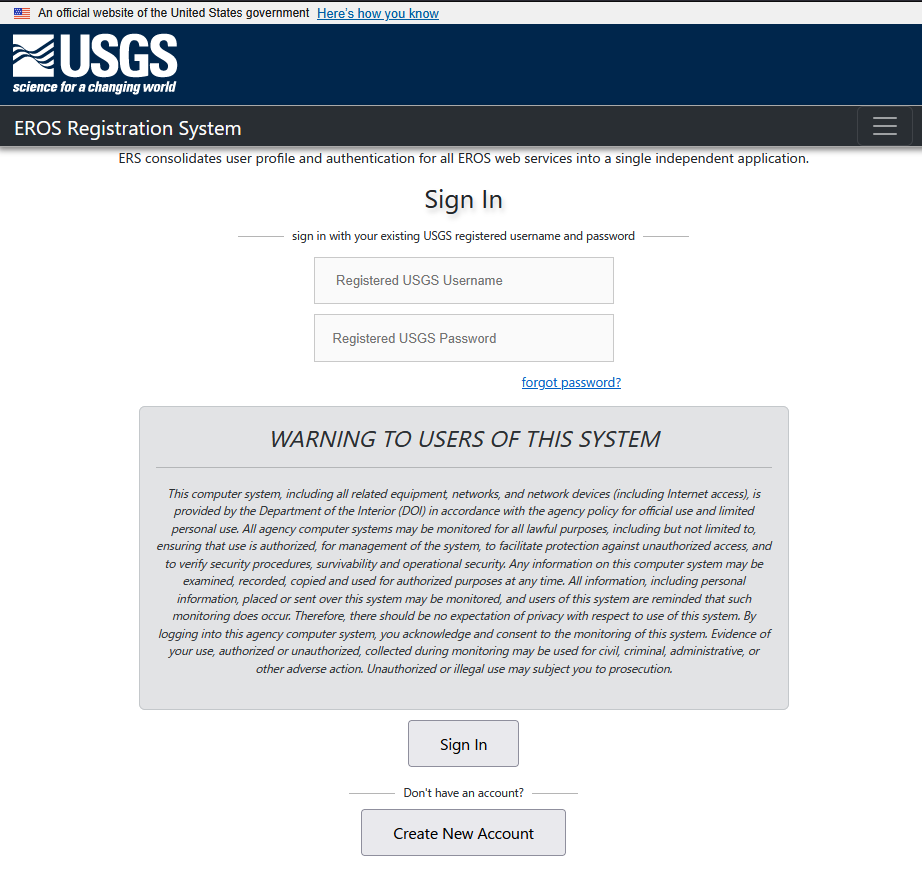
3-2 衛星データと地上データを組み合わせる準備
(省略)
3-3 GDAL を使った衛星データ処理
まずはとりあえずプロットしてみます。ちなみに、本でキャプションに「Landsat-8 courtesy of the U.S. Geological Survey」と書かれてましたが、USGS のデータを使う時は acknowledgement の書き方が決まっているみたいです(参考)。ということでここでもそれに合わせます。
library(terra)
b5 <- rast("path/to/LC08_L2SP_107035_20200429_20200820_02_T1_SR_B5.TIF")
plot(b5)
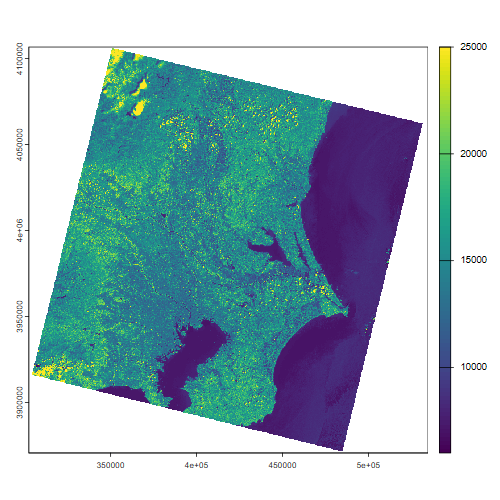
出典:Landsat-8 courtesy of the U.S. Geological Survey
値の分布の確認
値の分布を見るには hist() です。勝手にサンプリングしてやってくれるので便利。
hist(b5, breaks = 300)
#> Warning message:
#> [hist] a sample of 2% of the cells was used (of which 33% was NA)
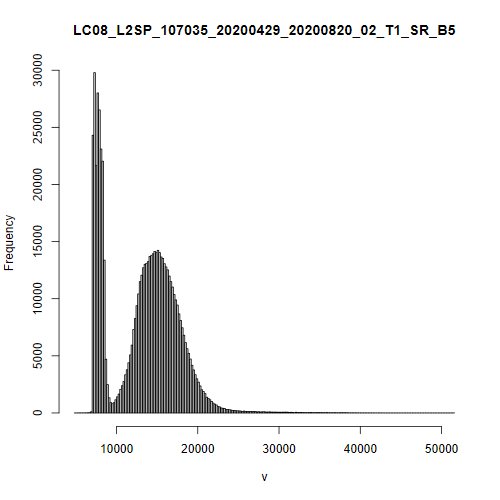
出典:Landsat-8 courtesy of the U.S. Geological Survey
上では plot() を使いましたが、base plot でのパレットのいじり方が分からないので tidyterra パッケージを使います。パレットがいっぱいありますが、GRASS のパレットの中にある grey がグレースケールです。
# 値を 6000~25000 に絞る
b5_tweak <- b5 |>
clamp(6000, 25000)
ggplot() +
geom_spatraster(data = b5_tweaked) +
scale_fill_grass_c(palette = "grey")
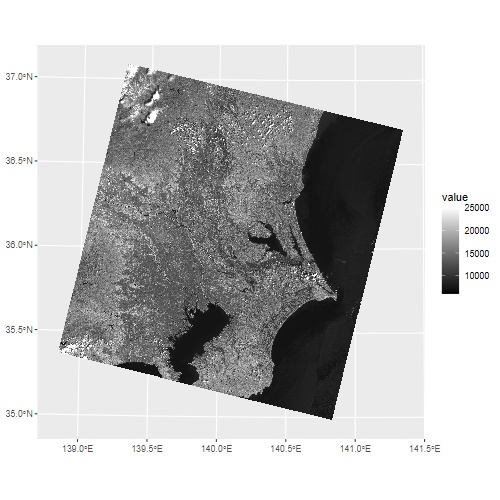
出典:Landsat-8 courtesy of the U.S. Geological Survey
3-3-3 画像の切り出し
画像の切り出しには terra::crop() を使います。ただ、本のようにピクセル単位(srcWin)で指定する方法はないみたいです。まあ別に緯度経度で指定できるし問題ないかー、と思いきや...
# xy=TRUE だと xmin, ymin, xmax, ymax の順になる
e <- ext(139.7101, 35.6721, 139.7201, 35.6841, xy = TRUE)
crop(b5, e)
#> Error:
#> ! [crop] extents do not overlap
なんと、エラーになってしまいます。よくわからないのですが、この ext() には CRS は設定できなくて、切り取り対象のラスタと同じ単位(つまりこの場合はメートル)で記述する必要があるようです。
そんなことはやってられないので、sf でポリゴンを作って投影変換して使うことにします。Geocomputation with R を見てもそうやっていたので、どうやらこれが正解っぽいです。うーん、crop() の中でいい感じに処理してほしい...[1]
poly <- sf::st_polygon(list(
rbind(
c(139.7101, 35.6721),
c(139.7201, 35.6721),
c(139.7201, 35.6841),
c(139.7101, 35.6841),
c(139.7101, 35.6721)
)
))
ext <- poly |>
sf::st_sfc(crs = 4326) |> # 緯度経度として扱うために WGS84 に
sf::st_transform(crs(b5)) # ラスタの CRS と合わせる
b5_mini <- crop(b5, ext)
plot(b5_mini)
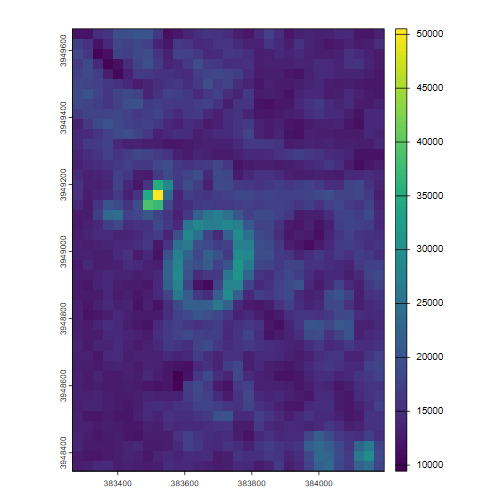
出典:Landsat-8 courtesy of the U.S. Geological Survey
3-3-4 カラー合成
extent が揃っているラスタデータは c() で束ねられます。
b2 <- rast("path/to/LC08_L2SP_107035_20200429_20200820_02_T1_SR_B2.TIF")
b3 <- rast("path/to/LC08_L2SP_107035_20200429_20200820_02_T1_SR_B3.TIF")
b4 <- rast("path/to/LC08_L2SP_107035_20200429_20200820_02_T1_SR_B4.TIF")
rgb <- c(b4, b3, b2)
rgb
#> class : SpatRaster
#> dimensions : 7871, 7741, 3 (nrow, ncol, nlyr)
#> resolution : 30, 30 (x, y)
#> extent : 302385, 534615, 3870585, 4106715 (xmin, xmax, ymin, ymax)
#> coord. ref. : WGS 84 / UTM zone 54N (EPSG:32654)
#> sources : LC08_L2SP_107035_20200429_20200820_02_T1_SR_B4.TIF
#> LC08_L2SP_107035_20200429_20200820_02_T1_SR_B3.TIF
#> LC08_L2SP_107035_20200429_20200820_02_T1_SR_B2.TIF
#> names : LC08_L2SP_~2_T1_SR_B4, LC08_L2SP_~2_T1_SR_B3, LC08_L2SP_~2_T1_SR_B2
トゥルーカラーでプロットするには、plotRGB() が使えます。この関数が受け付けるのは 0~255 の範囲の値なので、streatch() を指定して修正します。minvとmaxvはデフォルトの値と同じなので指定しなくて大丈夫ですが、ここでは説明のために書いています。以降は省略します。
rgb |>
crop(ext) |>
stretch(
smin = 7000, smax = 13500, # 入力の値の範囲
minv = 0, maxv = 255 # 出力される値の範囲(デフォルトの値)
) |>
plotRGB()
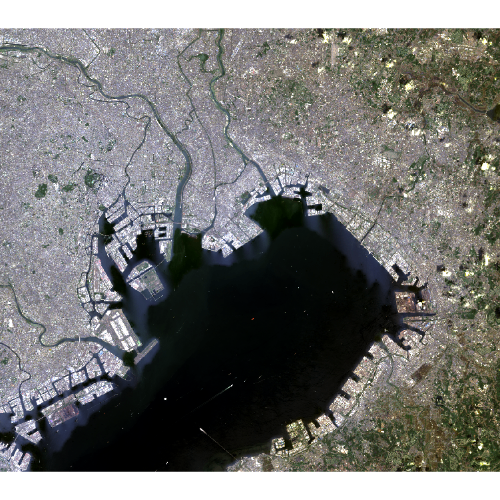
出典:Landsat-8 courtesy of the U.S. Geological Survey
smin、smax で直接値の範囲を指定するのではなく、minq、maxq でパーセンタイルを指定することもできます。例えば、上下5%を切り捨てるにはこんな感じです。
stretch(rgb, minq = 0.05, maxq = 0.95)
本でやっているように、バンドごとに値のスケールを調整してから束ねる場合はこんな感じのはずです(が、なんかこのデータの場合は見た目はイマイチでした。範囲を変える必要がある...?)。
rgb <- c(
b4 |> crop(ext) |> stretch(smin = 7000, smax = 13000),
b3 |> crop(ext) |> stretch(smin = 8100, smax = 12800),
b2 |> crop(ext) |> stretch(smin = 9700, smax = 13400)
)
plotRGB(rgb)
また、tidyterra の場合は geom_spatraster_rgb() という Geom が用意されています。plotRGB() も geom_spatraster_rgb() も、どのレイヤーを赤緑青のどれに割り当てるかを選ぶことができるので、今度はそのやり方でやってみます。
# まずは全部一つに束ねる
data <- c(b2, b3, b4, b5) |>
crop(ext) |>
stretch(minq = 0.05, maxq = 0.95)
do_plot <- function(r, g, b, title) {
ggplot() +
# 赤緑青それぞれの割り当てを r, g, b で指定する
tidyterra::geom_spatraster_rgb(data = data, r = r, g = g, b = b) +
ggtitle(title)
}
patchwork::wrap_plots(
do_plot(3, 2, 1, "True Color"),
do_plot(4, 3, 2, "False Color"),
do_plot(3, 4, 2, "Natural Color"),
nrow = 2
)
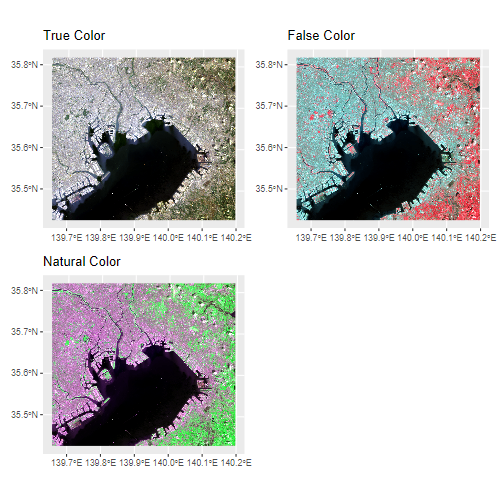
出典:Landsat-8 courtesy of the U.S. Geological Survey
3-3-5 パンシャープン画像の作成
パンシャープニングは、RStoolbox というパッケージの panSharpen() を使うとできるみたいです。
まずはデータの取得です。バンド8は level 2 ではなく level 1 にあるので、landsat-c2l1 を検索しなおします。scene_id は先ほど指定したものと同じです。
items <- stac_source |>
rstac::stac_search(
collections = "landsat-c2l1",
datetime = "2020-04-10T00:00:00Z/2020-06-11T00:00:00Z",
bbox = c(139.7081, 35.4818, 139.8620, 35.6594),
limit = 100
) |>
rstac::get_request()
items |>
rstac::items_filter(filter_fn = \(x) x$properties$`landsat:scene_id` == "LC81070352020120LGN00") |>
rstac::assets_url("pan")
#> [1] "https://.../LC08_L1TP_107035_20200429_20200820_02_T1_B8.TIF"
ダウンロードしたら、これを使って panSharpen() を使います。
pan <- rast("path/to/LC08_L1TP_107035_20200429_20200820_02_T1_B8.TIF")
# ディズニーランド周辺
poly <- sf::st_polygon(list(
rbind(
c(139.8697, 35.6403),
c(139.8971, 35.6403),
c(139.8971, 35.6212),
c(139.8697, 35.6212),
c(139.8697, 35.6403)
)
))
ext <- poly |>
sf::st_sfc(crs = 4326) |>
sf::st_transform(crs(b2))
# 重いのでまず crop しておく
orig <- c(b4, b3, b2) |> crop(ext)
pan <- pan |> crop(ext)
pansharpened <- panSharpen(orig, pan, r = 1, g = 2, b = 3)
結果です。なんかくっきりしている気がします。
p1 <- ggplot() +
tidyterra::geom_spatraster_rgb(data = stretch(orig, maxq = 0.95)) +
ggtitle("Original")
p2 <- ggplot() +
tidyterra::geom_spatraster_rgb(data = stretch(pansharpened, maxq = 0.95)) +
ggtitle("After")
patchwork::wrap_plots(p1, p2)

出典:Landsat-8 courtesy of the U.S. Geological Survey
続き
-
stars::st_crop()の方がどう見ても使いやすそう... ↩︎
Discussion